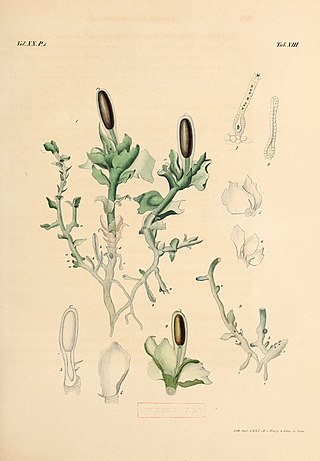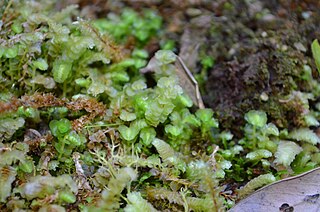
Biantheridion is a genus of liverwort in the family Anastrophyllaceae. Its only accepted species is Biantheridion undulifolium the marsh flapwort, or marsh earwort. It is found in Austria, China, the Czech Republic, Denmark, Finland, France, Germany, Greenland, North Korea, Norway, Poland, Russia, Sweden, Switzerland, and the United Kingdom. Its natural habitat is swamps. It is threatened by habitat loss.
Jamesoniella is a formerly accepted genus of liverworts. It is considered to be included in the genus Syzygiella, but one species, Jamesoniella convoluta, has not be transferred to that genus nor synonymized.
Schistochila vitreocincta is a species of liverwort in the family Schistochilaceae. Under its synonym Perssoniella vitreocincta it was the only species in the monotypic genus Perssoniella and family Perssoniellaceae. It is endemic to New Caledonia. Its natural habitat is subtropical or tropical dry forests.

Herbertaceae is a family of liverworts. The family consists of the genera Herbertus, Schisma and Triandrophyllum. The genus HerpocladiumMitten, 1873 was later merged into the genus Herbertus.
Phycolepidozia is a genus of liverwort in the family Cephaloziellaceae. It contains two species:
Vetaforma is a genus of liverworts found only in Argentina and Chile, and contains a single species Vetaforma dusenii. It is classified in the order Jungermanniales. It was placed as the only member of the family Vetaformaceae within that order, but this family has been merged into the family Lepicoleaceae based on morphological and genetic data. The genus name was originally published in 1960, but this publication was invalid under Article 36.1 of the International Code of Nomenclature for algae, fungi, and plants. The single species was first described in 1900 as Lepidozia dusenii and transferred to Vetaforma in 1962.

Acrobolbaceae is liverwort family in the order Jungermanniales.
Acrobolbus epiphytus is a liverwort species in the genus Acrobolbus. It occurs in New Zealand.

Gymnomitriaceae is a liverwort family in the order Jungermanniales.

Cephaloziaceae is a family of liverworts.

Leiomitra is a genus of liverworts in the family Trichocoleaceae.

Haplomitrium is a genus of liverworts.

Acrobolbus pseudosaccatus, synonym Tylimanthus pseudosaccatus, is a bryophyte, a species from the liverwort family Acrobolbaceae. The family grows on logs, rocks, and soil. Under certain circumstances, however, they are epiphyte, growing on other plant species.

Anastrophyllaceae is a family of liverworts belonging to the order Jungermanniales.
Balantiopsidaceae is a family of liverworts belonging to the order Jungermanniales.
Chonecoleaceae is a monotypic family of liverworts in the order Jungermanniales. It only contains the one genus Chonecolea.

Cleveaceae is a family of liverworts belonging to the order Marchantiales.
John E. Braggins is a New Zealand botanist and bryologist, known for his research into ferns and liverworts. Braggins lectured at the University of Auckland from 1969 until 2000, during which time he supervised and mentored a significant number of New Zealand botanists. During Braggins' career, he has taken part in the identification of 12 species and one suborder, many of which are endemic New Zealand liverworts.

Lophocolea mediinfrons is a species of liverwort in the family Lophocoleaceae. The plant was first described by John J. Engel and John E. Braggins in 2010 as Chiloscyphus mediinfrons, and has only been found on Ulva Island in New Zealand.

Schizophyllopsis is a genus of liverworts belonging to the family Anastrophyllaceae. The Anastrophyllum subgenus Schizophyllum was elevated to genus status by Jiří Váňa and Lars Söderström in 2013, however due to Schizophyllum being a name for a pre-existing genus, this was rectified and the new genus Schizophyllopsis was created.












